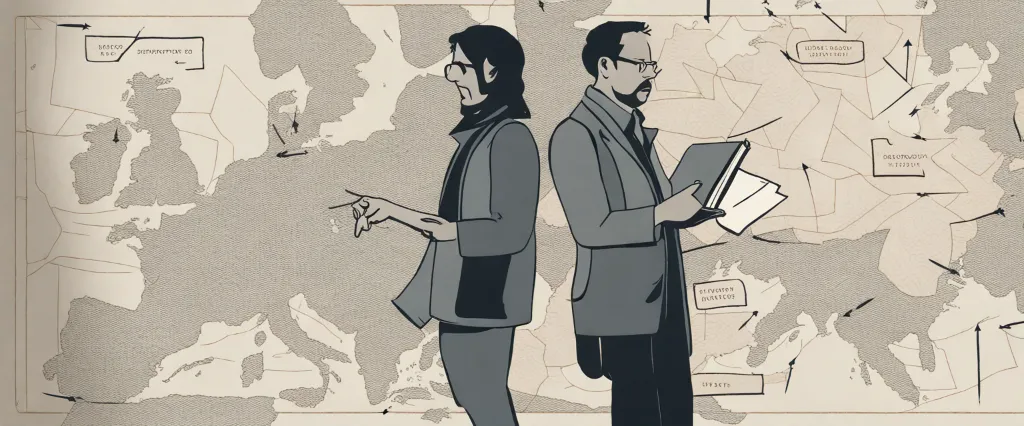——The Shortest History of Europe by John Hirst & Embracing Defeat by John W. Dower

In the vast ocean of historical literature, it is often the works that shine a light on the darkest periods of our past that resonate the most. Two such books, “The Shortest History of Europe” by John Hirst and “Embracing Defeat” by John W. Dower, offer unique perspectives on two profoundly transformative periods in European and Asian history, respectively. While seemingly disparate in subject matter and chronology, a closer examination reveals captivating parallels and thought-provoking contrasts between the two.
In “The Shortest History of Europe, Hirst embarks upon the arduous task of condensing centuries of complex European history into a concise and accessible narrative. This succinct work captures the essence of Europe’s multifaceted past, tracing its convoluted trajectory from the ancient civilizations of Greece and Rome to the dawn of the twenty-first century. Hirst’s book acts as a sweeping overview, exploring key events, individuals, and ideas that have shaped the continent over centuries.
On the other side of the globe, John W. Dower’s “Embracing Defeat” dives into the aftermath of World War II in Japan, presenting a penetrating analysis of the country’s struggle to rebuild amidst the ruins of its defeat. With meticulous research and empathetic storytelling, Dower delves deep into the psyche of post-war Japan, unearthing the complexities of its social, political, and cultural transformation. Through his extensive examination of the people’s resilience and the American occupation, Dower unveils the intricate process of rebuilding a nation from its very core.
While Hirst’s book focuses on a grand narrative of Europe’s history, Dower’s work zooms in on a specific moment in Japan’s past. However, both authors succeed in capturing the pulse of their respective histories. Hirst’s condensed approach provides readers with a panoramic view of Europe, allowing them to grasp the broader trends, conflicts, and shifts experienced across the continent. In contrast, Dower’s meticulous attention to detail enables readers to immerse themselves in the unique challenges faced by Japan in the aftermath of its defeat, offering a microcosmic examination of a transformative era.
As we embark on this comparative study of “The Shortest History of Europe” and “Embracing Defeat,” we will explore the parallels and divergences between these two seminal works. By juxtaposing the two books’ approaches to historical writing, their subject matters, and the lenses through which they interpret their respective histories, this study aims to uncover unexpected connections and shed light on the fascinating interplay of Europe’s past and Japan’s post-war reconstruction. From the broadest strokes to the smallest details, let us embark on this journey of exploration and understanding, as we navigate the corridors of history guided by the insights of John Hirst and John W. Dower.
Brief Summary of Two Books
The Shortest History of Europe by John Hirst
“The Shortest History of Europe” by John Hirst provides a concise and accessible overview of the complex and varied history of Europe. Hirst begins by tracing Europe’s origins in ancient Greece and Rome, highlighting their significant contributions to art, philosophy, and political thought. He then delves into the Middle Ages, exploring the rise and fall of feudalism, the development of nation-states, and the impact of the Renaissance. The book also covers the Reformation, the Age of Enlightenment, and the scientific and industrial revolutions, which shaped Europe’s cultural and intellectual landscape. Hirst navigates through the turbulent periods of European history, including the Napoleonic era, the World Wars, and the Cold War, analyzing their causes and consequences. Furthermore, he examines the formation and expansion of the European Union, shedding light on its challenges and accomplishments. With its brevity and clarity, “The Shortest History of Europe” serves as an engaging and informative introduction to the continent’s rich and intricate past.
Embracing Defeat by John W. Dower
Embracing Defeat: Japan in the Wake of World War II” by John W. Dower is a comprehensive study of post-war Japan and its transformation from a defeated nation to a modern democratic society. The book primarily focuses on the period from Japan’s surrender in 1945 to the early 1950s, highlighting the major social, political, and cultural changes that took place during this time.
Dower explores Japan’s initial shock and despair following their defeat, as the country faced the challenges of demobilization, economic devastation, and foreign occupation by the Allied forces. He delves into the socio-economic conditions, such as food shortages, inflation, and unemployment, that plagued the nation and led to a sense of hopelessness among the Japanese people.
The author also examines the different approaches taken by the United States and Japan in the process of occupation and reconstruction. Dower shows how the Americans, initially focused on demilitarization and democratization, played a fundamental role in reshaping Japanese society. He explores the development of new political structures, the creation of a new constitution, and the introduction of democratic institutions in Japan.
Throughout the book, Dower emphasizes the resilience and adaptability of the Japanese people, highlighting their ability to embrace change, rebuild their lives, and participate actively in the process of reconstruction. He explores various aspects of daily life, including the practice of bartering and black market activities, the rise of new social movements, and the transformation of traditional gender roles.
Furthermore, Dower delves into the cultural dimensions of post-war Japan, including the study of history and war memory, the role of popular media and entertainment, and the impact of American influence on Japanese society. He addresses the complexities of Japan’s war guilt and the emergence of a collective memory that aimed to reconcile the past with a vision for the future.
In conclusion, “Embracing Defeat” provides a compelling narrative of Japan’s post-war experience, examining both the challenges and achievements faced by the nation. Through meticulous research and captivating storytelling, Dower offers a thorough exploration of Japan’s profound transformation in the wake of World War II.
Comparison between Two Books

Similarities in Historic Spotlight
Both The Shortest History of Europe by John Hirst and Embracing Defeat by John W. Dower shed light on specific periods of European history and provide a historical spotlight on significant events and their consequences.
In The Shortest History of Europe, Hirst focuses on the major turning points and transformative events that shaped Europe’s identity over centuries. He outlines key historical moments, such as the fall of the Roman Empire, the Renaissance, the Reformation, the Age of Enlightenment, and both World Wars. Hirst’s approach to history is concise, highlighting the critical events and their broader implications for Europe’s development.
Similarly, Embracing Defeat by John W. Dower provides a historical spotlight on the immediate aftermath of World War II in Japan. Dower examines the impact of the war’s end on Japanese society, politics, and culture. He delves into topics such as the U.S. occupation, the Hiroshima and Nagasaki bombings, the Nuremberg-like trials held for Japanese war criminals, and the subsequent rebuilding efforts in Japan. Dower’s book aims to illuminate this particular historical period and the challenges faced by Japan in the wake of defeat.
Both books thus share the common characteristic of taking historical snapshots and focusing on specific periods. They zoom in on significant events and their consequences, allowing readers to gain a deeper understanding of the contextual factors at play and the far-reaching effects of these events on European and Japanese history respectively.
Divergences in Historic Spotlight
The Shortest History of Europe by John Hirst and Embracing Defeat by John W. Dower are both noteworthy books that provide valuable insights into European history. While they share some common ground in their examination of historical events, they differ in their focus and approach.
The first major divergence between these books is their historical spotlight. The Shortest History of Europe offers a concise overview of the continent’s history, aiming to cover the main events and driving factors that shaped Europe from ancient times to the present. It provides a broad understanding of European history, making it accessible to a wide audience. Hirst’s book focuses on the key themes and developments that impacted Europe as a whole, such as religion, politics, and commerce, rather than focusing on any one country or region. Thus, the historical spotlight in The Shortest History of Europe is more far-reaching and generalized across the continent.
On the other hand, Embracing Defeat by John W. Dower zooms in on a specific period and country, namely post-World War II Japan. Dower’s book delves into the complex and multifaceted aftermath of Japan’s defeat and occupation, analyzing how the nation coped with the challenges of a shattered economy, political restructuring, and cultural transformation. By focusing primarily on Japan, Dower is able to provide a detailed account of the specific historical events, political dynamics, and societal changes that occurred during this critical period. Consequently, the historical spotlight in Embracing Defeat is much narrower and tightly concentrated on post-war Japan.
While both books demonstrate meticulous research and analysis, the diverging historical spotlights influence the narrative structure and depth of examination. The Shortest History of Europe offers a wide-ranging perspective that fits its aim to provide a succinct overview, sacrificing some detail and context for brevity. Conversely, Embracing Defeat provides a comprehensive and highly detailed account of a specific period in Japanese history, allowing for a deeper exploration of the subject matter.
In conclusion, the divergence in historical spotlight is a significant factor that distinguishes The Shortest History of Europe by John Hirst and Embracing Defeat by John W. Dower. Hirst takes a broader approach, covering the entirety of Europe’s history, while Dower zooms in on post-war Japan. It ultimately comes down to the reader’s preference, as each book provides an illuminating and unique perspective on history.

Conclusion
Both “The Shortest History of Europe” by John Hirst and “Embracing Defeat” by John W. Dower are highly regarded books in their respective genres. It ultimately depends on your specific interests and preferences, as these two books offer different perspectives and focus on different aspects of European history.
“The Shortest History of Europe” provides a concise overview of European history, making it an excellent choice for readers looking for a broad understanding of the continent’s history in a brief format. Hirst’s book covers key events, trends, and ideas from ancient times to the present, offering a comprehensive yet accessible account.
On the other hand, “Embracing Defeat” delves specifically into the history of post-World War II Japan, exploring the country’s transition from wartime defeat to a new democratic era. It is a meticulously researched and highly informative book that delves into the complexities of Japan’s reconstruction, the occupation by Allied forces, and the societal changes that followed.
In summary, if you are interested in a general overview of European history, “The Shortest History of Europe” is a great choice. However, if you have a specific interest in post-war Japanese history and its socio-political transformation, “Embracing Defeat” would be more suitable.



